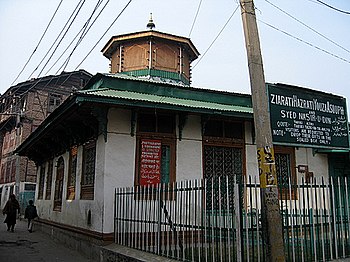| Revision as of 08:50, 9 April 2009 editSmackBot (talk | contribs)3,734,324 editsm Date maintenance tags and general fixes← Previous edit | Revision as of 07:18, 25 May 2009 edit undoLilaac (talk | contribs)2,544 editsNo edit summaryNext edit → | ||
| Line 3: | Line 3: | ||
| '''Roza Bal''' is the name of a shrine located in the Khanyar district of ], in ], ], venerated by some ], ] and ]. Some people identify the sage buried there with one ] and with ], whom they allege to have arrived in Kashmir after surviving his ].<ref>Several authors have held the view that Jesus had travelled to the Indian subcontinent including ] and the Russian traveler ].</ref> | '''Roza Bal''' is the name of a shrine located in the Khanyar district of ], in ], ], venerated by some ], ] and ]. Some people identify the sage buried there with one ] and with ], whom they allege to have arrived in Kashmir after surviving his ].<ref>Several authors have held the view that Jesus had travelled to the Indian subcontinent including ] and the Russian traveler ].</ref> | ||
| The tomb itself consists of a low rectangular building on a raised platform, surrounded by railings at the front. It has three arches at the front, where entry can be had, and four arches at the side. Inside is a rock carving that is said to show feet bearing crucifixion wounds. | The tomb itself consists of a low rectangular building on a raised platform, surrounded by railings at the front. It has three arches at the front, where entry can be had, and four arches at the side. Inside is a rock carving that is said to show feet bearing crucifixion wounds. The body is buried according to the Jewish tradition of directions and not according to rules of Islam. However, the building also houses the burial tomb of a local Muslim saint who has been buried in line with Islamic directions. | ||
| The tomb had previously been maintained by local descendants of the buried sage. It is currently maintained by a Board of Directors consisting of ]. Sahibzada Basharat Saleem, a former ] (now deceased), claimed to hold genealogical tables that link him as a direct descendant of the buried sage.<ref>James Polster: . Yahoo! News, May 15, 2006</ref> In recent times another man was buried there, who is revered by some local Muslims as a ] saint, although others point to historical data that he was only the shrine's long-serving caretaker.{{Fact|date=December 2007}} | The tomb had previously been maintained by local descendants of the buried sage. It is currently maintained by a Board of Directors consisting of ]. Sahibzada Basharat Saleem, a former ] (now deceased), claimed to hold genealogical tables that link him as a direct descendant of the buried sage.<ref>James Polster: . Yahoo! News, May 15, 2006</ref> In recent times another man was buried there, who is revered by some local Muslims as a ] saint, although others point to historical data that he was only the shrine's long-serving caretaker.{{Fact|date=December 2007}} | ||
Revision as of 07:18, 25 May 2009
| This article includes a list of references, related reading, or external links, but its sources remain unclear because it lacks inline citations. Please help improve this article by introducing more precise citations. (April 2009) (Learn how and when to remove this message) |

Roza Bal is the name of a shrine located in the Khanyar district of Srinagar, in Kashmir, India, venerated by some Muslims, Hindus and Buddhists. Some people identify the sage buried there with one Yuz Asaf and with Jesus, whom they allege to have arrived in Kashmir after surviving his crucifixion.
The tomb itself consists of a low rectangular building on a raised platform, surrounded by railings at the front. It has three arches at the front, where entry can be had, and four arches at the side. Inside is a rock carving that is said to show feet bearing crucifixion wounds. The body is buried according to the Jewish tradition of directions and not according to rules of Islam. However, the building also houses the burial tomb of a local Muslim saint who has been buried in line with Islamic directions.
The tomb had previously been maintained by local descendants of the buried sage. It is currently maintained by a Board of Directors consisting of Sunni Muslims. Sahibzada Basharat Saleem, a former caretaker (now deceased), claimed to hold genealogical tables that link him as a direct descendant of the buried sage. In recent times another man was buried there, who is revered by some local Muslims as a Sufi saint, although others point to historical data that he was only the shrine's long-serving caretaker.
Notes
- Roza Bal, The Tomb of Jesus by Fida Hassnain and Suzanne Olsson, Booksurge in USA, Gulshan Pub. in India (2008) 9781419697586 Examines the tomb history and its links with Jesus as Yuz Asaf.
- Several authors have held the view that Jesus had travelled to the Indian subcontinent including Mirza Ghulam Ahmad and the Russian traveler Nicolas Notovitch.
- James Polster: Mystery of the Martyr's Tomb. Yahoo! News, May 15, 2006
A search for the Historical Jesus by Prof. Fida Hassnain. Gill & Macmillian, Ireland
The Fifth Gospel by Fida Hassnain. Bluedolphin Publishing.USA
External links
- The Tomb of Jesus Website (site examines theory of Jesus in India. Includes videos and photos of Roza Bal)
- Pictures of Roza Bal (site subscribes to the identification with Jesus)
Categories: